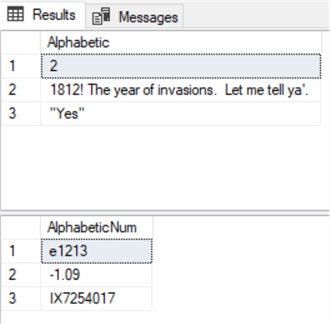Transact- SQL Syntax Conventions. How to regex in a MySQL query - Stack. REGEXP_ LIKE is similar to the LIKE condition, except REGEXP_ LIKE performs regular expression matching instead of the simple pattern matching performed by LIKE. The REGEXP_ LIKE condition uses the input character set to evaluate strings.
If you specify match_parameter values that conflict, the REGEXP_ LIKE condition will use the last value to break the conflict. If the match_parameter is omitte the REGEXP_ LIKE condition will use the case-sensitivity as determined by the NLS_SORT parameter. Unlike MySQL and Oracle, SQL Server database does not support built-in RegEx functions. However, SQL Server offers built-in functions to tackle such complex issues.
Examples of such functions are LIKE , PATINDEX, CHARINDEX, SUBSTRING and REPLACE. We can combine these functions with others and create a sophisticated and more complex query. REGEXP_ LIKE Examples : In my previous article, I have explained different regular expressions with its description. In this article, I will try to give the regular.
GILT FÜR: SQL Server Azure SQL-Datenbank Azure SQL Data Warehouse Parallel Data Warehouse APPLIES TO: SQL Server Azure SQL Database Azure SQL Data Warehouse Parallel Data Warehouse. Bestimmt, ob eine bestimmte Zeichenfolge mit einem angegebenen Muster. Regular expression support is implemented with a set of Oracle Database SQL functions that allow you to search and manipulate string data. You can use these functions in any environment where Oracle Database SQL is used. See Oracle Database SQL Functions for Regular Expressions later in this chapter for more information.
SQL REGEXP_ LIKE () function same as like condition but matching regular expression pattern to perform like condition. The LIKE operator is used in a WHERE clause to search for a specified pattern in a column. Unlike LIKE and SIMILAR TO, POSIX is not a keyword that is used in a SQL query. POSIX is a set of comparators for case matches and non equivalency. MySQL uses the extended version to support regular expression pattern-matching operations in SQL statements.

Regex does not use = and ! I have a bit of code that converts a Sql Like expression to a regex expression for the purposes of a Linq to objects Like extension method. For some time I have been using this conversion. We can use some comparable expressions to a full regular expression library for matching certain patterns with T- SQL using the like operator.
This conversion replaces all with. You can still take a look, but it might be a bit quirky. REGEXP and RLIKE operators check whether the string matches pattern containing a regular expression. Finding or replacing text in SQL is a very frequent scenario. SQL pattern matching enables you to use _ to match any single character and to match an arbitrary number of characters (including zero characters).
In MySQL, SQL patterns are case-insensitive by default. Some examples are shown here. Whereas LIKE only performs simple pattern matching using the wildcards and _, REGEXP_ LIKE performs complex regular expression pattern matching allowing it to match a much greater range of string patterns than LIKE. The following examples compare pattern matching with both LIKE and REGEXP_ LIKE. Microsoft SQL Server, for example, supports a limited variant of POSIX-style regular expressions.
We use regular expressions to define specific patterns in T- SQL in a LIKE operator and filter based on specific conditions. We also call these regular expressions as T- SQL RegEx functions. The first Oracle LIKE example that we will look at involves using the wildcard (percent sign wildcard). For those of the uniquely SQL Server persuasion, this may not even be a big deal. SQL regular expressions are a curious cross between LIKE notation and common regular expression notation.
LIKE and PATINDEX are often used but, unfortunately. Therefore, you should describe the meaning of the regular expression in the comment of the SQL statement. In addition, the speed of data retrieval, in some cases, is decreased if you use complex patterns in a regular expression.
The abbreviation of regular expressions is regex or regexp. I want to search in internal tables lines like I do this in where expression of sql , but thought the instrumentality of RegEx. For example, internal table have. LIKE syntax for pattern is simple and supports a small set of wildcards, but does not support the full regular expression syntax.
If you are interested in learning more about pattern matching and the LIKE operator, check out the SQL Basics course. It will show you how to build queries from scratch, but it will also introduce practical skills like pattern matching. To get your RegEx right I suggest you first develop and test it using Oracle SQL Developer.
Only if you have a working RegEx add it as part of your big pass-through SQL query in SAS. Der SQL LIKE Befehl ermöglicht eine auf der Grundlage eines vorher definierten regulären Musters anstelle eines festen Suchbegriffs (wie bei SQL IN) oder der Definition eines Bereichs (wie bei SQL BETWEEN). Oft wird der SQL Like Befehl in Texten bzw.
Zeichenketten verwendet, um mit regulären Mustern Ergebnisse zurückzuliefern.
Keine Kommentare:
Kommentar veröffentlichen
Hinweis: Nur ein Mitglied dieses Blogs kann Kommentare posten.